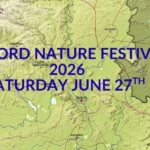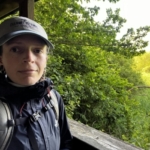Acoustic monitoring fieldwork in the Scottish Highlands
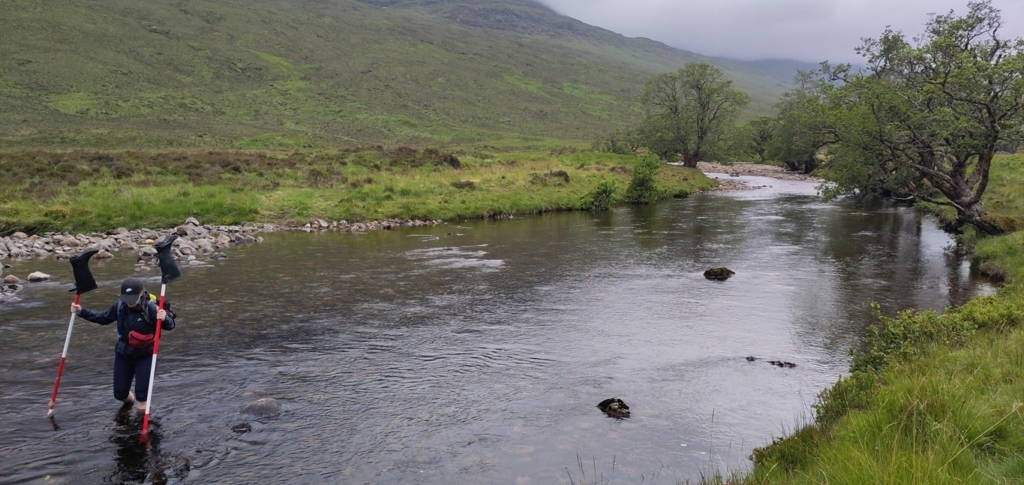
We have just completed two weeks of successful data collection in Caledonian pinewood in the Scottish Highlands. Using passive acoustic monitoring to survey bats and birds, and trialling a method for assessing invertebrates.
As often happens with fieldwork, we had a clear reminder that you should always expect the unexpected and be prepared to adapt plans. Two days before we were due to leave Ella had a bike accident, leading to a mild concussion and a collection of bruises. After the all-clear from A&E and 24 hours’ delay, we set off for Scotland, very grateful for the contingency day we had built into a fairly tight schedule.
We have been working in a Caledonian pinewood remnant in Glen Mallie, which runs south from Loch Arkaig. Glen Mallie’s pinewood lost many of its mature Scots pines after a fire in the 1940s and has since struggled to regenerate due to the impact of deer browsing the young trees. We are interested to understand how this affects the birds, bats, other mammals, and insects it supports, comparing the species found in the remnant to adjacent areas of regenerating pinewood on the shore of Loch Arkaig and to the unforested heathland nearby. A fence has recently been put up around this remnant to exclude deer from the forest and give the young trees a chance to grow and establish.
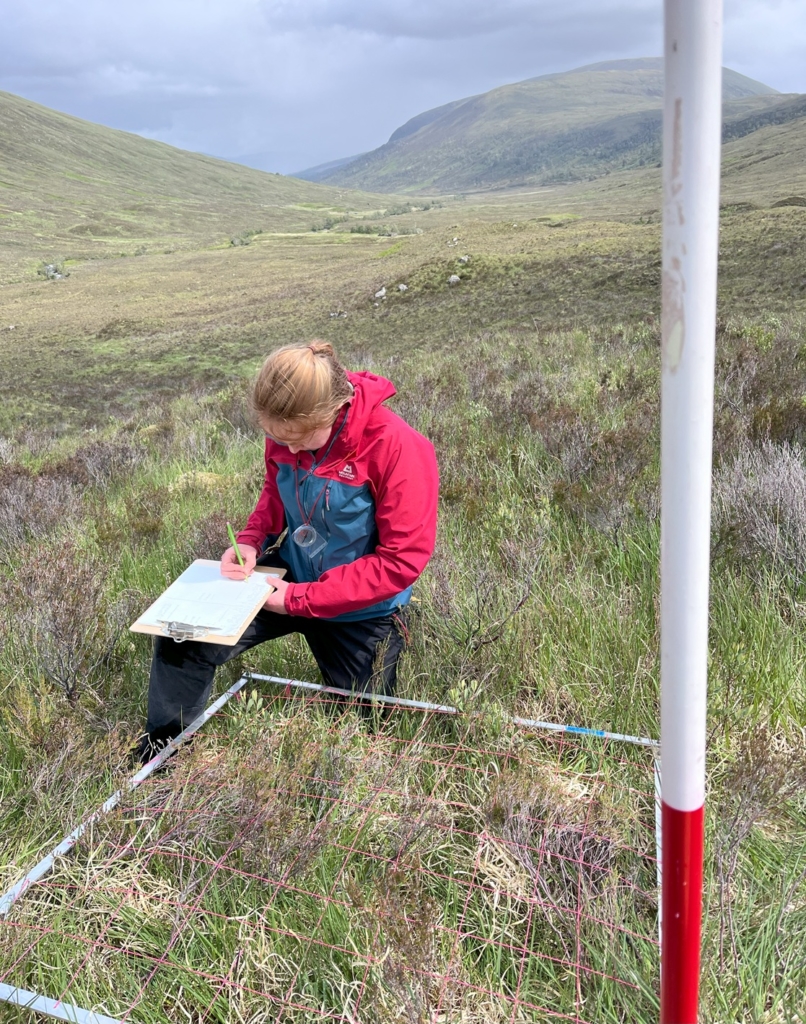 Working in fairly remote sites, with sampling points spaced a minimum of 500m from each other, the project has required a lot of walking. Pushing our way through dense heather and bracken, crossing streams and bogs, and scrambling up and down hills, we have been intimately connected to the landscape (and very familiar with the ground on the many occasions we have fallen over). In addition, one of the regenerating woodland sites, the Gusach, was only accessible from Loch Arkaig, requiring the use of a boat. We were fortunate to have the assistance of Liam, Loch Arkaig Site Manager for Woodland Trust Scotland, who on several days kindly ferried us across the Loch and back. These challenges in accessing our sites highlighted the benefit that passive acoustic monitoring can bring in this wilder environment. Collecting multiple days and nights of data without the need for exhausting repeated trips over difficult terrain; hard enough in daylight and frankly dangerous to attempt during the nighttime.
Working in fairly remote sites, with sampling points spaced a minimum of 500m from each other, the project has required a lot of walking. Pushing our way through dense heather and bracken, crossing streams and bogs, and scrambling up and down hills, we have been intimately connected to the landscape (and very familiar with the ground on the many occasions we have fallen over). In addition, one of the regenerating woodland sites, the Gusach, was only accessible from Loch Arkaig, requiring the use of a boat. We were fortunate to have the assistance of Liam, Loch Arkaig Site Manager for Woodland Trust Scotland, who on several days kindly ferried us across the Loch and back. These challenges in accessing our sites highlighted the benefit that passive acoustic monitoring can bring in this wilder environment. Collecting multiple days and nights of data without the need for exhausting repeated trips over difficult terrain; hard enough in daylight and frankly dangerous to attempt during the nighttime.
The upside of our slow progress on foot has been full immersion in a landscape humming with life. The sheer abundance of wildlife, and rare plants round every corner, is a joy for any ecologist, a stark reminder of all we have lost in much of the UK, and a call to protect, celebrate, and restore the biodiversity of the Highlands. The puddles in boggy hollows are full of newts, frogs leap ahead of you with every step, dragonflies skim past, butterflies and moths flit through the heather, lizards scurry out of sight, and on a couple of days golden eagles soared above us. In the forest, we have stumbled (often literally) across carpets of wood sorrel, alpine lady’s mantle, and the pinewood specialist serrated wintergreen. On the open hill the bogs are filled with insectivorous round and oblong-leaved sundews and common butterwort, and lesser butterfly orchids are beginning to flower. All the while, birds peep and pip, chit and chirp, trill and twit around, filling out the soundscape. Our sampling points were allocated on a 500 m grid before we set out, each one taking us to a random point in the forest that we might never otherwise have visited. This led to the discovery of our favourite tree of the trip. A gnarled alder with a rowan and holly growing embedded from the rotten centre of its trunk. From a distance the three trees create the perfect rounded form of a single tree, but looking up from below each species stands out, making up the canopy of a mixed native woodland. In the moss growing near the base of the alder’s trunk we spotted a tiny birch seedling, a possible future addition to this mini community.
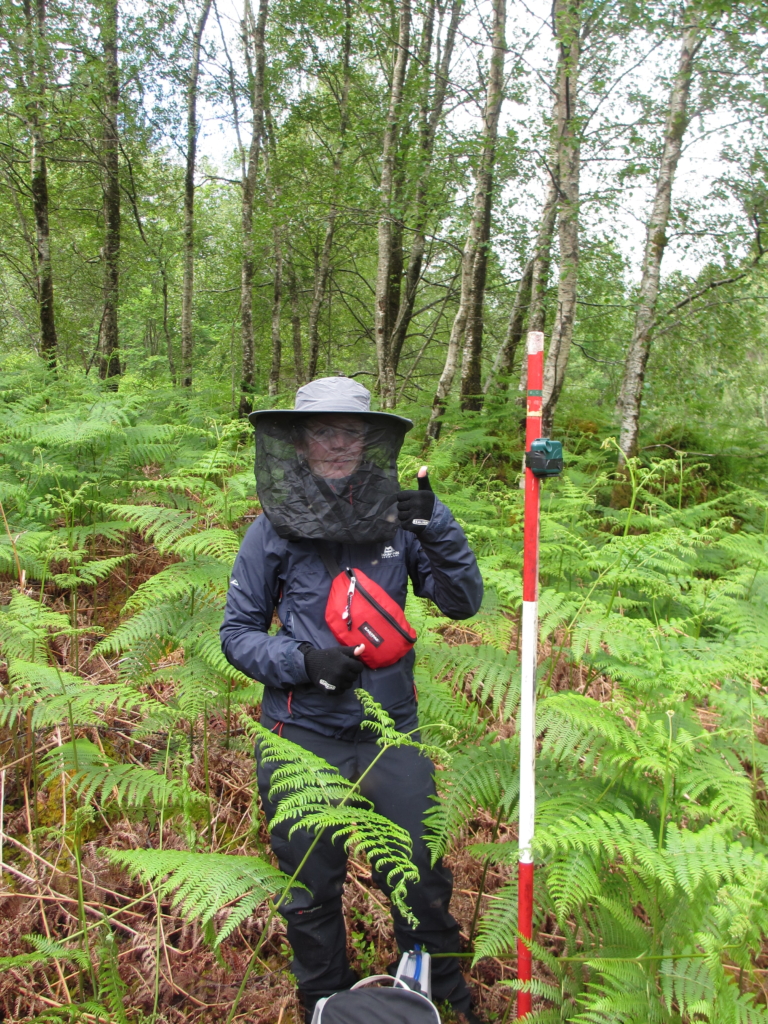 Anyone who has visited the Highlands will know the weather can be reliably variable and we experienced showers, wind, and sunny spells most days. Unfortunately, on a few days and nights, the wind and rain impacted our audio recordings, causing lower activity of our study fauna as well as extra background noise. Despite our mixed luck with the weather, initial scans of the audio data have shown diverse species activity. Many bird species can be heard calling, including rare Eurasian Treecreeper calls in the regenerating forest. We were surprised to discover a particularly determined Eurasian Wren begin its dawn chorus at 2:30 am, with the rest of the community – including chaffinches, wood and grasshopper warblers, great tits, blackbirds, and robins – waking up more slowly. Excitingly, four bat species’ echolocation calls were recorded at the forest sites, with feeding buzzes and social calls also detected. In one recording, two Soprano Pipistrelles can be heard interacting as one echolocates, catching midges in-flight, while the other, likely a male, makes attempts at serenading with melodic chirrups. Other small mammal sounds were picked up too, such as the shrill squeak of a pygmy shrew.
Anyone who has visited the Highlands will know the weather can be reliably variable and we experienced showers, wind, and sunny spells most days. Unfortunately, on a few days and nights, the wind and rain impacted our audio recordings, causing lower activity of our study fauna as well as extra background noise. Despite our mixed luck with the weather, initial scans of the audio data have shown diverse species activity. Many bird species can be heard calling, including rare Eurasian Treecreeper calls in the regenerating forest. We were surprised to discover a particularly determined Eurasian Wren begin its dawn chorus at 2:30 am, with the rest of the community – including chaffinches, wood and grasshopper warblers, great tits, blackbirds, and robins – waking up more slowly. Excitingly, four bat species’ echolocation calls were recorded at the forest sites, with feeding buzzes and social calls also detected. In one recording, two Soprano Pipistrelles can be heard interacting as one echolocates, catching midges in-flight, while the other, likely a male, makes attempts at serenading with melodic chirrups. Other small mammal sounds were picked up too, such as the shrill squeak of a pygmy shrew.
Part of this pilot survey work was to assess the possibility of using passive acoustics to monitor invertebrates in this landscape and insect buzzes can be heard in many recordings, which is promising.
Back in Oxford we are beginning analysis, using a combination of AI pipelines and manual verification of the songs and calls to generate species presence and activity data within each habitat type. We are really excited to see what the results tell us about the bird, bat, other mammal, and invertebrate communities that the remnant pinewood supports, and how this compares to the better quality pinewood nearby and adjacent unforested habitat.
We would like to thank Liam at Woodland Trust Scotland, Jared at Arkaig Community Forest, Ian at Bidwells, and Achnacarry Estate for sharing their local knowledge, facilitating site access and making this project possible.

